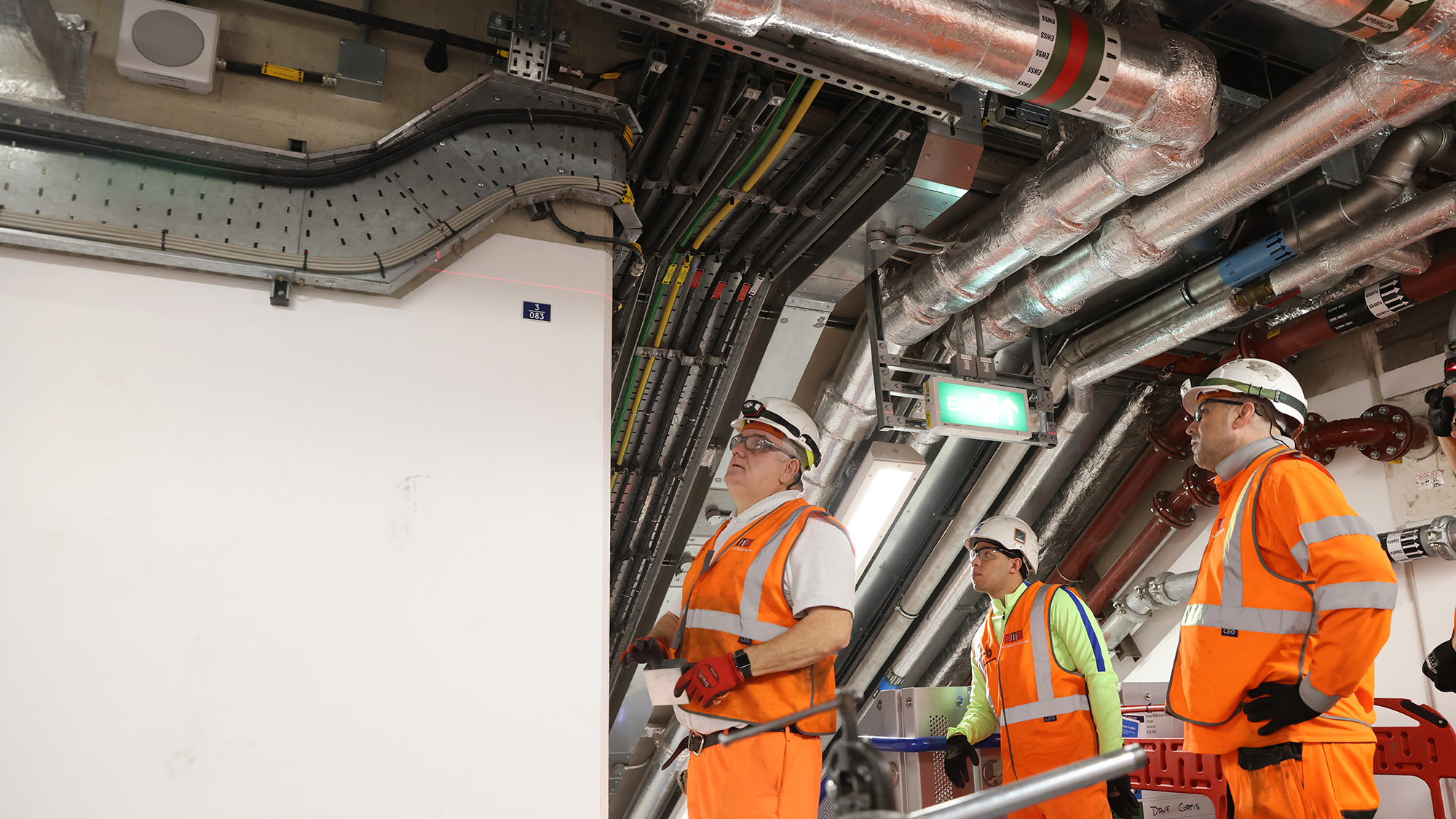
Digital connectivity is key to unlocking the potential of urban areas, allowing places and communities to be connected and establishing efficient and reliable public services.
High-quality, high-capability digital infrastructure and ultra-fast reliable connectivity creates opportunities for innovation, as well as economic and social benefits.
In 2021, Boldyn Networks signed a 20-year partnership with Transport for London (TfL) to provide high-speed mobile coverage across the London Underground network.
Known as the Telecoms Commercialisation Project (TCP), or Connected London, it is one of the largest infrastructure programmes of its type and will support the capital's transformation into a smarter and safer city.
We are working with Transport for London to provide seamless high-speed fourth- and fifth- generation (4G and 5G) connectivity across the entire underground network and ensure greater digital inclusion across the capital.
When the project is complete, customers of all the UK's mobile network operators (MNOs) Three UK, EE, Vodafone and Virgin Media O2, will be able to access high-speed mobile connectivity while travelling on the Tube.
We are funding the installation of the 4G and 5G equipment, and shared infrastructure is being installed for all four MNOs to use.
Installing four separate sets of radio equipment in the confines of Tube stations and tunnels would have been prohibitive in terms of the space available and the disruption it would cause, so this shared infrastructure presents a more sustainable and efficient solution. Over the 20-year term of the contract, Boldyn charges a fee to the MNOs to enable a return on its investment.
Solutions to time and space constraints
The historical importance of some TfL stations also means that maintaining the conditions and aesthetics is a key part of the project, while bringing one of the world's oldest underground networks into the digital age. There is no such thing as a standard underground station and the heritage stations in particular, such as Covent Garden, Piccadilly Circus and Kings Cross, have to be treated with great care.
Boldyn has experience designing, building and operating critical communications networks in confined spaces in complex urban environments, including New York, San Francisco and Hong Kong. To this end it has designed special equipment to fit inside tight tunnel spaces, with electronics housed in special cabinetry, and using no equipment that requires fan cooling, as this can affect the reliability of the equipment.
Specially designed radio units are installed throughout the stations and concourses to beam the cellular signal to phones. Meanwhile, a 175mm-diameter radiating cable is installed on the tunnel walls at train window height to provide signal to passing Tube services.
This is known as a leaky feeder as it has gaps or slots in its outer conductor to allow the radio signal to leak into or out of the cable along its entire length – both are compliant with current regulations. For longer tunnels, a high-power radio unit is installed every 500m to amplify the signals.
As many of the Tube lines run 20 hours a day, much of the work underground happens in engineering hours – a four-hour window in the early mornings. Our installation partners employ more than 500 people, accessing stations and tunnels every night and working in as many as 30 stations at one time.
Because the work is constrained in terms of both time and space, the activities are a logistical balancing act. Finding space for cabinet and radio provision is key, as well as tasks such as floor-loading assessments, fire engineering compliance and electrical upgrades. We also ensure the electronics equipment does not add extra heat to the environment, and check that it works at different temperatures.

Installing a new cable management system route that will provide 4G and 5G coverage. © Boldyn Networks
Single network supports multiple parties
As part of Connected London, we are establishing a new high-speed optical fibre network of 200km to form the backbone for digital connectivity across the Tube. The network will run deep underground and present itself at key stations on the surface, as well as traversing street-level ducts across TfL's Red Route major road system. This will allow public bodies, carriers and businesses to access fibre.
TfL has given us access to more than 80,000 street assets from traffic lights to bus stops, to mount equipment and draw power and these form an integral part of the ability to provide the level of connectivity required to ensure a prosperous future for the city.
In the capital today, even if mobile coverage is strong, users often experience a capacity crunch or spinning wheel on their smartphones at peak times in busy locations.
Typically, MNOs provide city coverage through a series of high cell sites, but with rooftop availability being a premium and planning permission issues, a new street-level based network can house MNO small cells, which can manage high data rates and high densities of device – vital in a 5G world. These small cells have already been activated in the King's Cross area, with many more to come.
Using street assets not only boosts wireless connectivity, it also enables innovation using sensor technology and the Internet of Things that will pave the way to improve the city. These include air-quality sensors, sensor-based waste monitoring and footfall data. The network can enhance city planning and benefit residents, visitors and businesses.
The neutral host model is well suited to busy and densely populated urban areas such as London. Shared networks and infrastructure represent cost-effective, innovative ways of achieving connectivity in complex and challenging environments.
This approach means partners – often government authorities and transport or mobile network operators – can reduce their costs and provide infrastructure that reaches more people at a faster pace than multiple networks over the same footprint.
As such this is a highly efficient system, economically beneficial not just to the host but also to the businesses that use the infrastructure at relatively low cost, without having to build or maintain the underlying network.
'The neutral host model is well suited to busy and densely populated urban areas such as London'
Buildings benefit from new fibre network
At the heart of the London project, we have created a number of strategically located base station hotel (BSH) sites across travel zones 1–9. Acting as data centres, they house the key MNO equipment, eliminating the need for excessive technology on TfL's premises. Mobile signals are directed from these sites along fibre routes deep into the underground, without the need for bulky equipment in stations or tunnels.
This network can provide an additional benefit. The BSHs can act as centralised hubs, providing seamless connectivity. The facilities can house radio equipment providing signal for buildings and venues enabling rapid and cost-effective deployment.
It is unobtrusive, only requiring a fraction of the space previously needed in target buildings. Less equipment means less power consumption, minimising energy costs and any associated carbon footprint.
For landlords and building owners, it is an alternative to the difficult installation of in-building cellular networks and having to deal with multiple MNOs. The bulky equipment this requires can be an eyesore and logistically challenging – especially when it needs upgrading. Many buildings also struggle with connectivity, given that modern construction materials shield radio waves. With 80% of calls made or received in buildings, that is a significant problem.
The outcome is a premier 4G or 5G signal from a network that makes efficient use of space, reduces energy consumption and is easier to manage and upgrade than its standard counterparts. This enables reliable in-building connectivity that's affordable for property owners and managers. We are also providing mobile connectivity for entertainment and sports locations, such as the Olympia London exhibition centre in Kensington.
Project shows potential of neutral host networks
Connected London could in the future provide benefits for residents and local businesses in the London boroughs, including adult social care, as well as mitigating climate risk, using air quality sensors.
Councils could also improve connectivity by leveraging their street assets, ducting and other resources, and could look to Sunderland City Council's experience of being part of a connected smart city.
There are opportunities for TfL to benefit public transport beyond the Tube as well, for example the wireless network will allow the monitoring of assets underground such as escalators, lifts and signs.
Housing association and council properties could also be connected to the network so that social housing tenants have access to high-speed internet connectivity, helping to increase digital inclusion.
There are opportunities to work with local councils to use their assets such as ducting to create neutral host networks, which only have to be installed once. By working with private-sector partners over the long term, local authorities can get better connectivity and then generate revenue without the risks and disruption associated with building and operating network infrastructure.
Mobile connectivity on the Tube network is just one of the stages in London's smart city journey. Unlocking the capital's potential requires a connectivity strategy that will allow it to take advantage of innovative technologies and create opportunities for residents and businesses.
Andrew Conway is group director, technology strategy, Boldyn Networks
Related competencies include: Health and safety, Landlord and tenant, Legal/regulatory compliance, Smart cities and intelligent buildings

